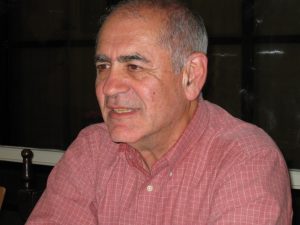Today In Miami at the age of 83 passed away a well known Russian and American automata theory scientist Leonid Rosenblum. He was my mentor and closest friend. Here is some brief information about his career. In Russian.
Леонид Яковлевич Розенблюм (5 марта 1936 г. – 2 апреля 2019 г.), канд. техн.наук, доцент – пионер мажоритарной логики, самосинхронной схемотехники, теории и применений сетей Петри в моделировании и проектировании цифровых схем и параллельных систем.В течение 20 лет, с 1960г. по 1980г., занимался с коллегами (в группе профессора В.И. Варшавского) наукой и приложениями (например, разработкой новой схемотехники и надежных бортовых компьютеров) в Вычислительном центре Ленинградского отделения Математического института им. В.А. Стеклова АН СССР.
С 1981г. по 1989 г. работал доцентом кафедры математического обеспечения и применения ЭВМ в ЛЭТИ им. В.И. Ульянова-Ленина (ныне Санкт-Петербургский государственный электротехнический университет). В 90-х годах после эмиграции в США работал адъюнкт-профессором в Бостонском университете, а также исследователем в Гарвардском университете.
Соавтор/автор пяти книг, около двух сотен различных изданий, учебных пособий, статей и обзоров, более 40 авторских свидетельств на изобретения.
Среди его учеников – профессора университетов России, Великобритании, США, Финляндии и других стран, сотрудники институтов АН Российской Федерации, таких как Институт Проблем Управления, а также известных отечественных и зарубежных компаний, таких как Intel, Cadence, Xilinx и т.д.
Леонида Яковлевича отличало врожденное свойство видеть в людях только положительные качества, помогать всем и во всем, и конечно необыкновенное чувство юмора. Эта утрата для огромного числа людей повсюду, всех кому посчастливилось его знать или слышать о нем.
Leonid Yakovlevich Rosenblum (March 5, 1936 – April 2, 2019), Cand. Technical Sciences, Associate Professor – a pioneer of majority logic, self-timed circuit design, theory and applications of Petri nets in the modeling and design of digital circuits and parallel systems.
Among his students are professors from universities in Russia, the United Kingdom, the United States, Finland and other countries, employees of institutes of the Academy of Sciences of the Russian Federation, such as the Institute of Management Problems, as well as well-known domestic and foreign companies such as Intel, Cadence, Xilinx, etc.

